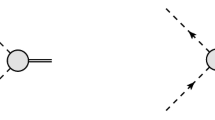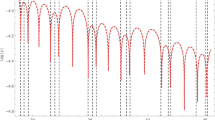Abstract
We suggest a framework based on the rainbow approximation to the Dyson–Schwinger and Bethe–Salpeter equations with effective parameters adjusted to lattice QCD data to calculate the masses of the ground and excited states of pseudo-scalar glueballs. The structure of the truncated Bethe–Salpeter equation with the gluon and ghost propagators as solutions of the truncated Dyson–Schwinger equations is analyzed in Landau gauge. Both, the Bethe–Salpeter and Dyson–Schwinger equations, are solved numerically within the same rainbow–ladder truncation with the same effective parameters which ensure consistency of the approach. We found that with a set of parameters, which provides a good description of the lattice data within the Dyson–Schwinger approach, the solutions of the Bethe–Salpeter equation for the pseudo-scalar glueballs exhibit a rich mass spectrum which also includes the ground and excited states predicted by lattice calculations. The obtained mass spectrum contains also several intermediate excitations beyond the lattice approaches. The partial Bethe–Salpeter amplitudes of the pseudo-scalar glueballs are presented as well.






Similar content being viewed by others
Notes
In the present paper we use the four-dimensional Levi–Civita symbol \(\epsilon ^{\mu \nu \alpha \beta }\) normalized according to the Itzykson-Zuber convention (see Appendix A-10 in Ref. [57]), i.e. \(\epsilon ^{0123}=1\), \(\epsilon ^{\mu \nu \alpha \beta } \epsilon {_{\mu \nu }}^{\alpha '\beta '} =2 (g^{\alpha \beta '}g^{\beta \alpha '}-g^{\alpha \alpha '}g^{\beta \beta '}) \), \(\epsilon ^{\mu \nu \alpha \beta } \epsilon _{\mu \nu \alpha \beta }=-24\).
It should be noted that the most recent publication [22] does not longer consider the excited states, so that the state \(M_{gg}^{(\mathrm{1st.})}=3640\pm 189\) MeV should be considered with some caution.
References
H. Fritzsch, P. Minkowski, Nuovo Cim. A 30, 393 (1975)
R.L. Jaffe, K. Johnson, Phys. Lett. B 60, 201 (1976)
U. Wiedner, Prog. Part. Nucl. Phys. 66, 477 (2011)
S. Jia et al., Belle Collaboration. Phys. Rev. D 95, 012001 (2017)
D. Robson, Z. Phys, Z. Phys. C 3, 199 (1980)
N. Isgur, J.E. Paton, Phys. Rev. D 31, 2910 (1985)
C.E. Carlson, T.H. Hansson, C. Peterson, Phys. Rev. D 30, 1594 (1984)
M.S. Chanowitz, S.R. Sharpe, Nucl. Phys. B 222, 211 (1983). [Erratum Nucl. Phys. B 228, 588 (1983)]
J.M. Cornwall, A. Soni, Phys. Lett. B 120, 431 (1983)
Y.M. Cho, X.Y. Pham, P. Zhang, J.J. Xie, L.P. Zou, Phys. Rev. D 91, 114020 (2015)
N. Boulanger, F. Buisseret, V. Mathieu, C. Semay, Eur. Phys. J. A 38, 317 (2008)
J. Leutgeb, A. Rebhan, Phys. Rev. D 101, 014006 (2020)
L. Bellantuono, P. Colangelo, F. Giannuzzi, JHEP 10, 137 (2015)
Y. Chen, M. Huang, Chin. Phys. C 40, 123101 (2016)
F. Brunner, A. Rebhan, Phys. Lett. B 770, 124 (2017)
M.A. Shifman, A.I. Vainshtein, V.I. Zakharov, Nucl. Phys. B 147, 385 (1979)
E.V. Shuryak, Nucl. Phys. B 203, 116 (1982)
A. Pimikov, H.J. Lee, N. Kochelev, P. Zhang, V. Khandramai, Phys. Rev. D 96, 114024 (2017)
A. Pimikov, H.J. Lee, N. Kochelev, Phys. Rev. Lett. 119, 079101 (2017)
A. Pimikov, H.J. Lee, N. Kochelev, P. Zhang, Phys. Rev. D 95, 071501 (2017)
M. Albanese et al., Ape Collaboration. Phys. Lett. B 197, 400 (1987)
Y. Chen, A. Alexandru, S. Dong, T. Draper, I. Horvath et al., Phys. Rev. D 73, 014516 (2006)
C.J. Morningstar, M.J. Peardon, Phys. Rev. D 60, 034509 (1999)
G. Gabadadze, Phys. Rev. D 58, 055003 (1998)
W. Ochs, J. Phys. G 40, 043001 (2013)
H. Noshad, S.M. Zebarjad, S. Zarepour, Nucl. Phys. B 934, 408 (2018)
H. Sanchis-Alepuz, C.S. Fischer, C. Kellermann, L. von Smekal, Phys. Rev. D 92, 034001 (2015)
J. Meyers, E.S. Swanson, Phys. Rev. D 87, 036009 (2013)
E.V. Souza, M.N. Ferreira, A.C. Aguilar, J. Papavassiliou, C.D. Roberts, S.-S. Xu, Eur. Phys. J. A 56, 25 (2020)
P. Maris, C.D. Roberts, Phys. Rev. C 56, 3369 (1997)
S.M. Dorkin, T. Hilger, L.P. Kaptari, B. Kämpfer, Few Body Syst. 49, 247 (2011)
P. Maris, C.D. Roberts, Int. J. Mod. Phys. E 12, 297 (2003)
R. Alkofer, P. Watson, H. Weigel, Phys. Rev. D 65, 094026 (2002)
C.S. Fischer, P. Watson, W. Cassing, Phys. Rev. D 72, 094025 (2005)
M.R. Frank, C.D. Roberts, Phys. Rev. C 53, 390 (1996)
S.M. Dorkin, L.P. Kaptar, B. Kämpfer, Phys. Rev. C 91, 055201 (2015)
S.M. Dorkin, L.P. Kaptari, T. Hilger, B. Kampfer, Phys. Rev. C 89, 034005 (2014)
V.B. Berestetskii, E.V. Lifshitz, L.P. Pitaevskii, Quantum Electrodynamics (Pergamon Press, Oxford, 1982), p. 29
L.P. Kaptari, B. Kämpfer, P.-M. Zhang, Eur. Phys. J. Plus 134, 383 (2019)
A. Hauck, L. von Smekal, R. Alkofer, Comput. Phys. Commun. 112, 149 (1998)
S. Mandelstam, Phys. Rev. D 20, 3223 (1979)
K. Buttner, M.R. Pennington, Phys. Rev. D 52, 5220 (1995)
D. Atkinson, J.C.R. Bloch, Phys. Rev. D 58, 094036 (1998)
L. von Smekal, A. Hauck, R. Alkofer, Phys. Rev. Lett. 79, 3591 (1997)
C.S. Fischer, e-Print: hep-ph/0304233 (Univ. of Tübingen, PhD-thesis, Nov 2002)
L. von Smekal, A. Hauck, R. Alkofer, Ann. Phys. 267, 1 (1998). [Erratum: Ann. Phys. 269, 282 (1998)]
C.S. Fischer, R. Alkofer, H. Reinhardt, Phys. Rev. D 65, 094008 (2002)
C.S. Fischer, A. Maas, J.M. Pawlowski, Ann. Phys. 324, 2408 (2009)
A.C. Aguilar, D. Binosi, J. Papavassiliou, Phys. Rev. D 78, 025010 (2008)
Ph Boucaud, J.P. Leroy, A. Le Yaouanc, J. Micheli, O. Pene, J. Rodriguez-Quintero, Few-Body Syst. 53, 387 (2012)
C.S. Fischer, J. Phys. G 32, R253 (2006)
P.O. Bowman, U.M. Heller, D.B. Leinweber, M.B. Parappilly, A. Sternbeck, L. von Smekal, A.G. Williams, J. Zhang, Phys. Rev. D 76, 094505 (2007)
A. Sternbeck, M. Müller-Preussker, Phys. Lett. B 276, 396 (2013)
M. Huber, arXiv:2003.13703 [hep-ph]
V.G. Bornyakov, V.K. Mitrjushkin, M. Müller-Preussker, Phys. Rev. D 81, 054503 (2010)
V.G. Bornyakov, E.-M. Ilgenfritz, C. Litwinski, M. Müller-Preussker, V.K. Mitrjushkin, Phys. Rev. D 92, 074505 (2015)
C. Itzykson, J.-B. Zuber, Quantum Field Theory (McGraw-Hill, New York, 1980)
D. Zwanziger, Nucl. Phys. B 323, 513 (1989)
M. Stingl, Phys. Rev. D 34, 3863 (1986). [Erratum ibid. D 36, 651 (1987)]
A. Cucchieri, D. Dudal, T. Mendes, N. Vandersickel, Phys. Rev. D 85, 094513 (2012)
S. Strauss, C.S. Fischer, C. Kellermann, Prog. Part. Nucl. Phys. 67, 239 (2012)
S. Strauss, C.S. Fischer, C. Kellermann, Phys. Rev. Lett. 109, 252001 (2012)
P. Maris, Phys. Rev. D 52, 6087 (1995)
J. Meyers, E.S. Swanson, Phys. Rev. D 87, 036009 (2013)
S.M. Dorkin, M. Beyer, S.S. Semikh, L.P. Kaptari, Few Body Syst. 42, 1 (2008)
S.M. Dorkin, L.P. Kaptari, C. Ciofi degli Atti, B. Kämpfer, Few Body Syst. 49, 233 (2011)
T. Hilger, M. Gomez-Rocha, A. Krassnigg, Eur. Phys. J. C 77, 625 (2017)
V.A. Karmanov, J. Carbonell, H. Sazdjian, EPJ Web Conf. 204, 01014 (2019)
V.A. Karmanov, J. Carbonell, H. Sazdjian, e-Print: arXiv:1903.02892
V.A. Karmanov, J. Carbonell, H. Sazdjian, e-Print: arXiv:2001.00401
Acknowledgements
This work was supported in part by the Heisenberg—Landau program of the JINR—FRG collaboration, GSI-FE and BMBF. LPK appreciates the warm hospitality at the Helmholtz-Zentrum Dresden-Rossendorf.
Author information
Authors and Affiliations
Corresponding author
Additional information
Publisher's Note
Springer Nature remains neutral with regard to jurisdictional claims in published maps and institutional affiliations.
Appendices
Appendix A: Partial Decomposition of the Rainbow Kernel
The spatial dependence of the integrand on \(\varOmega _{{\mathbf {k}}}\) is contained in the rainbow exponents and in the scalar product \((p\cdot k)^\delta = ({\tilde{p}}\ {\tilde{k}} \ x_{kp})^\delta \),
where \(\alpha =2{\tilde{k}}{\tilde{p}}/\omega ^2\). The partial coefficients \(W_{M_v}^{(\delta )}({\tilde{p}},{\tilde{k}}) \) can be computed explicitly as
where \(I_{M_v+1}(\alpha )\) are the modified Bessel functions of second kind (of the imaginary argument) yielding
The dependence on the spatial angles of the vectors p and k enters via \(G_{M_v}^{(1)}(x_{kp}\equiv \cos \xi _{kp})\), where \(\cos \xi _{kp}=\cos \xi _p\cos \xi _k + \sin \xi _p\sin \xi _k\cos \theta _{{\mathbf {kp}}}\). Explicitly, such a dependence can be written by using an addition theorem for Gegenbauer polynomials
with \( Z_{M_v l\mu }(k)=Z_{M_v l\mu }(\xi _k,\theta _{{\mathbf {k}}},\phi _{{\mathbf {k}}})\) as hyper-spherical harmonics, to obtain
where the normalized hyperspherical harmonics are \(Z_{M_v l\mu }(p) = X_{M_v l}(\xi _p) \mathrm{Y}_{l\mu }({\mathbf {p}})\) with
At a first glance, Eqs. (26)–(31) seemingly even complicate the integration. However, by observing that the dependence of the integrand in (6) on the spatial angles \(\varOmega _{{\mathbf {k}}}\) is only through the interaction kernel and trough \(x_{kp}^\delta \), Eq. (30), i.e. only trough the spatial harmonics \(\mathrm{Y}_{l\mu }({\mathbf {k}})\), the integration over \(d\varOmega _{{\mathbf {k}}}\) is trivial and eventually we have
Appendix B: Integration over \(x_k\)
Here, we present some details of the integration over the hyper angle \(x_k\) and the resulting explicit expressions of selection rules. The corresponding angular integral is of the form
Due to parity restrictions, the partial amplitudes \(F_{M_k}\) contain only even values of the Gegenbauer polynomials, i.e. \(M_k=[0,2,4,.. M^{max}]\), where \( M^{max}\) is the maximum number of polynomials taken into account in concrete calculations. The Gegenbauers \(G_{M_v}^{(1)}(x_k)\), which come from the interaction kernel (32), may contain both, even and odd values of \(M_v\), and formally the summation is extended to infinite, \(M_v=[0..\infty ]\). However, not all values in this interval contribute to (33). The symmetrical limits of integration restrict the Gegenbauer polynomials in (33) to obey the condition (\(L+M_k+M_v\))=even. Other restrictions originate from the explicit expression of the integral, see below. From a standard math handbook one infers that
where \({}_3F_2\) is the generalized hypergeometric function and \((a)_k=a (a+1)(a+2)\ldots (a+k-1)\) (with \(a_0=1\)) is the known Pochhammer symbol and \(B(x,y)=\frac{\varGamma (x)\varGamma (y)}{\varGamma (x+1)}\) and \(\varGamma (x)\) are the familiar Euler \(\beta -\) and \(\varGamma -\) functions, respectively. Despite the integral (34) is finite, at some values of \(L,M_k\) and \(M_v\) the product of the Pochhammer symbol and hypergeometric function can be of the type \(0 \cdot \infty \), which implies that Eq. (34) cannot be implemented directly into numerical calculations. One needs to handle zeros and singularities manually. We use the obvious properties
to obtain
where, for brevity, we introduce the shorthand notation \(\kappa =\frac{L+M_k+M_v}{2}\), \(\kappa _1=\frac{L-M_k-M_v}{2}\).
With this notation, the integral (34) reads
In Eq. (38) the summation is restricted by those values of k which ensure non-negative factorials, i.e. in the above sum \(k\le M_k\) and \(k\le M_v\) and \((M_k+M_v-L+2k)\ge 0\). Together with the condition \((L+M_k+M_v)\)-even, these restrictions form the selecting rules for the integral (33). Actually, in practice the summation in (38) consists only of one, or, at maximum, two terms. Consequently, the integrals (33) turn out to be extremely simple, being expressed in form of the fractional parts of \(\pi \). For instance, the value L=0 results in the orthogonal condition for the Gegenbauer polynomials i.e. \({{\mathcal {K}}}_{M_k,M_v}^{L=0}=\frac{\pi }{2}\delta _{M_k,M_v}\). For \(L=1\) one has \(M_v=1,3,5,7\) and for even \(M_k=0,2,4,6,8\) the integral (33) is always \(\pi /4\). Here we present the corresponding explicit expressions of the integrals (33) for \(M_k^{max}=8\):
Appendix C: Explicit Expressions for the Coefficients \(C_{L,\delta }({\tilde{k}},{\tilde{p}},x_p)\) in Eq. (22)
Recall that \(M_p\) comes from the decomposition of the amplitude in l.h.s., \(M_k\) is the decomposition of the BS amplitude under the integral in the r.h.s. of Eq. (22), and \(M_v\) comes from decomposition of the rainbow interaction. Eventually, \(\delta \) corresponds to the power of the scalar product \((k\cdot p)^\delta \) and L is the power of \(k_4^L\) which we meet after contractions over the Lorentz indices. Results of the contraction provide \(L=0,1,2,3\) and \(\delta =0,1,2,3)\) and that \(L+\delta _{max}=3\). It implies that not all possible combination of \(L,\delta \) in \(C_{L,\delta }({\tilde{k}},{\tilde{p}})\) contribute to the r.h.s. There are 10 possible combinations: \((L,\delta ) =(0,0)\), \((L,\delta ) =(0,1)\), \((L,\delta ) =(0,2)\), \((L,\delta ) =(0,3)\), \((L,\delta ) =(1,0)\), \((L,\delta ) =(1,1)\), \((L,\delta ) =(1,2)\), \((L,\delta ) =(2,0)\), \((L,\delta ) =(2,1)\), \((L,\delta ) =(3,0)\). Explicitly one has
Actually, expressions (55–58) imply that the summation \(\sum _{L,\delta }\) in Eq. (22) is restricted to \(\sum _{L=0}^3\sum _{\delta =0}^{\delta _{max}}\), where \(L+\delta _{max}=3\).
Rights and permissions
About this article
Cite this article
Kaptari, L.P., Kämpfer, B. Mass Spectrum of Pseudo-Scalar Glueballs from a Bethe–Salpeter Approach with the Rainbow–Ladder Truncation. Few-Body Syst 61, 28 (2020). https://doi.org/10.1007/s00601-020-01562-4
Received:
Accepted:
Published:
DOI: https://doi.org/10.1007/s00601-020-01562-4




